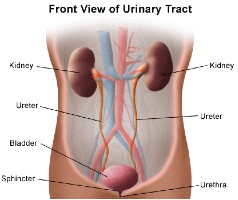Stony Brook Urology's specialized team of endourologists (stone specialists) provides patients with comprehensive and individualized care for the diagnosis and treatment of stone disease, or kidney stones.
Kidney stones, or nephrolithiasis, develop when substances such as calcium, oxalate, cystine, or uric acid are at high levels in the urine. Some stones may stay in the kidney without causing any issues, but others may attempt to move through the ureter and towards the bladder. This is a condition known as urolithiasis. If the stone gets stuck and blocks urine from passing, it may result in varying levels of pain.
Overview of the Urinary Tract System
 Kidneys: The kidneys are two bean-shaped organs that are located on each side of the spine and sit right below the ribcage. They act as a filter system for your body, removing waste products and excess fluids through the urine.
Kidneys: The kidneys are two bean-shaped organs that are located on each side of the spine and sit right below the ribcage. They act as a filter system for your body, removing waste products and excess fluids through the urine.
Ureter: The ureters are thin tubes that connect the kidneys to the bladder. Their primary job is to transport urine.
Bladder: The bladder is a spherical-shaped organ in the lower abdomen that expands, relaxes, and contracts to store and empty urine.
Urethra: The urethra is a passageway in the body's pelvic region that allows urine to pass outside the body.
Common Stone Types
Calcium Stones: These are the most common type of kidney stones. Calcium stones originate from having too much calcium in the urine, which is a condition called nephrocalcinosis. This can happen from the body absorbing too much calcium from the intestines and the bones or simply being unable to correctly regulate the amount of calcium released into the urine.
Cystine Stones: Cystine stones are a rarer type of stone that forms in those who have inherited a metabolic disorder that causes higher levels of cystine in the urine.
Struvite Stones: Struvite stones are made of a mixture of magnesium, ammonium, phosphate, and calcium carbonate. These stones commonly form due to infection with bacteria that produce ammonia. This raises the pH of the urine, promoting the formation of struvite.
Uric Acid: When the body metabolizes protein, uric acid is produced. When the pH of the urine drops below 5.5 it becomes saturated with uric acid crystals, causing stones to form. This tends to be more common in those who consume large amounts of protein.
Symptoms and Diagnosis
Symptoms of kidney stones include:
- Pain in the side, back, and/or groin
- Pain that starts suddenly and comes in waves
- Pain or burning while urinating
- Feeling an intense need to urinate
- Blood in urine
- Gravel or small stones in the urine
Diagnosis
A physical examination and intake of medical history is required to diagnose kidney stones. This is commonly followed by a urinalysis (testing of urine), an abdominal x-ray, CT scan, or an ultrasound to complete the diagnosis.
Visit your doctor if you are experiencing any of the conditions above to determine a treatment method.
Common Treatment Options
Dietary Changes: Your physician may recommend certain dietary changes, such as increasing your fluid intake, decreasing animal protein in your diet, reducing dietary salt, and increasing your intake of calcium-rich foods.
Medication: Depending on the kidney stone, medication may be prescribed to assist in the passing of the stone or to prevent its growth.
Stenting: Ureteral stents hold open the ureters, and can be used to prevent or treat ureteral obstructions such as stones. Stents tend to be about 10 to 15 inches long and line the length of the ureter from the kidney to the bladder.
Extracorporeal Shock wave lithotripsy (ESWL): High-energy shock waves are emitted toward the stone used to break the stone into smaller pieces. Only used for stones 1 cm or less in the kidney and upper ureter. This procedure lasts about 45 to 60 minutes and is administered from outside the body.
Ureteroscopy: A thin scope is used to view the kidney stone and remove it or break it into smaller pieces
Percutaneous Nephrolithotomy (PCNL): A minimally invasive surgery that is typically performed to remove larger stones by using a small telescope inserted through a small incision in the back.
Laser Lithotripsy: This is a procedure that is often performed during a ureteroscopy. A laser fiber is inserted through a scope in your urinary tract to break up stones.
Post Treatment Care
Stone Analysis: A stone analysis may be used to find out what the stone is made of. This can help your doctor understand why the stone was formed and how additional formation can be prevented in the future.
24-Hour Urine Collection: A 24-hour urine collection can assess if there are still abnormal levels in the urine. This is key to preventing stone recurrence.
Recommendations: Additional post-treatment care may depend on which treatment option was chosen for the patient. Please consult your doctor on next steps.
Special Stone Situations
Pregnancy and Stones: Stone formation during pregnancy can be caused by lack a of fluids, especially when the baby is pressing against the mother's bladder. Smaller stones may pass on their own, however, larger stones may require treatment. If larger stones go untreated, they can interfere with labor and delivery, and the baby.
Children and Stones: Although stones typically occur in adults, they can also affect children and babies. Consult a doctor if your child is experiencing intense pain in the lower back or sides, frequent or painful urination, nausea and vomiting, or blood in the urine. Increased fluid intake may aid in the stones passing, however, antibiotics or additional intervention may be required. To prevent stones in children, it is important that your child drinks enough fluids and reduces intake of salty foods.
FAQ and Resources
What causes kidney stones?
Kidney stones do not have one definitive cause, but certain factors can increase your risk, including:
- Dehydration
- Diet (eating foods with too much salt or sugar)
- Excessive body weight
- Pre-existing medical conditions
- Certain medications and supplements
Can kidney stones go away on their own?
If the stone is small enough, it may pass through the urinary tract on its own. The larger the stone, the more likely it is to become stuck, blocking the flow of urine.
Are kidney stones dangerous?
Kidney stones may be painful, but as long as they are treated in a timely manner, they usually will not cause permanent damage.
How can I prevent kidney stones in the future?
Increasing fluid intake, reducing the intake of foods containing high salt or oxalate content, and reducing the intake of animal protein are all recommended ways to prevent stones.
Additional Resources:
Our Team
 |
 |
| David Schulsinger, MD | Gauthami Churukanti, MD |

